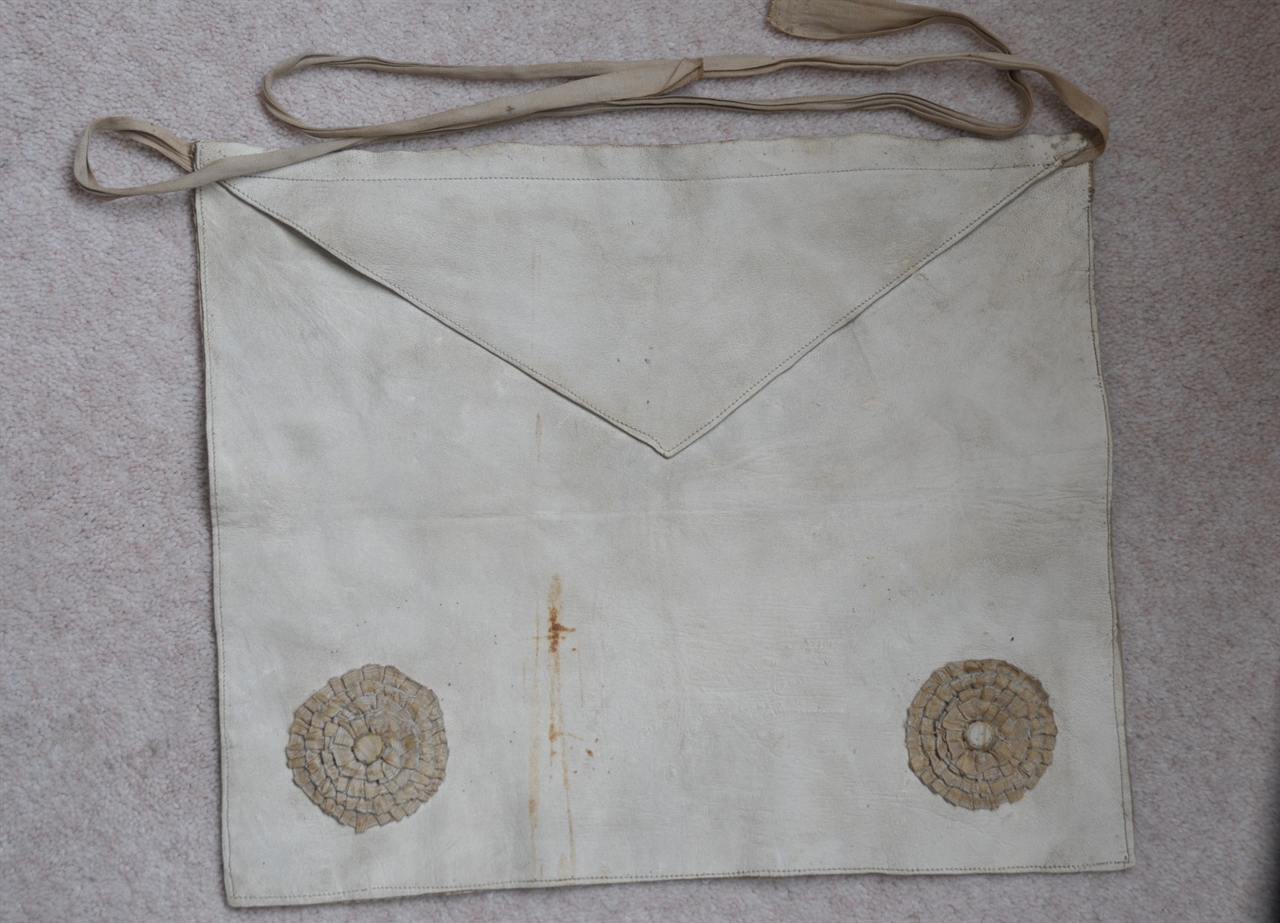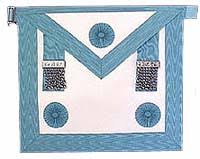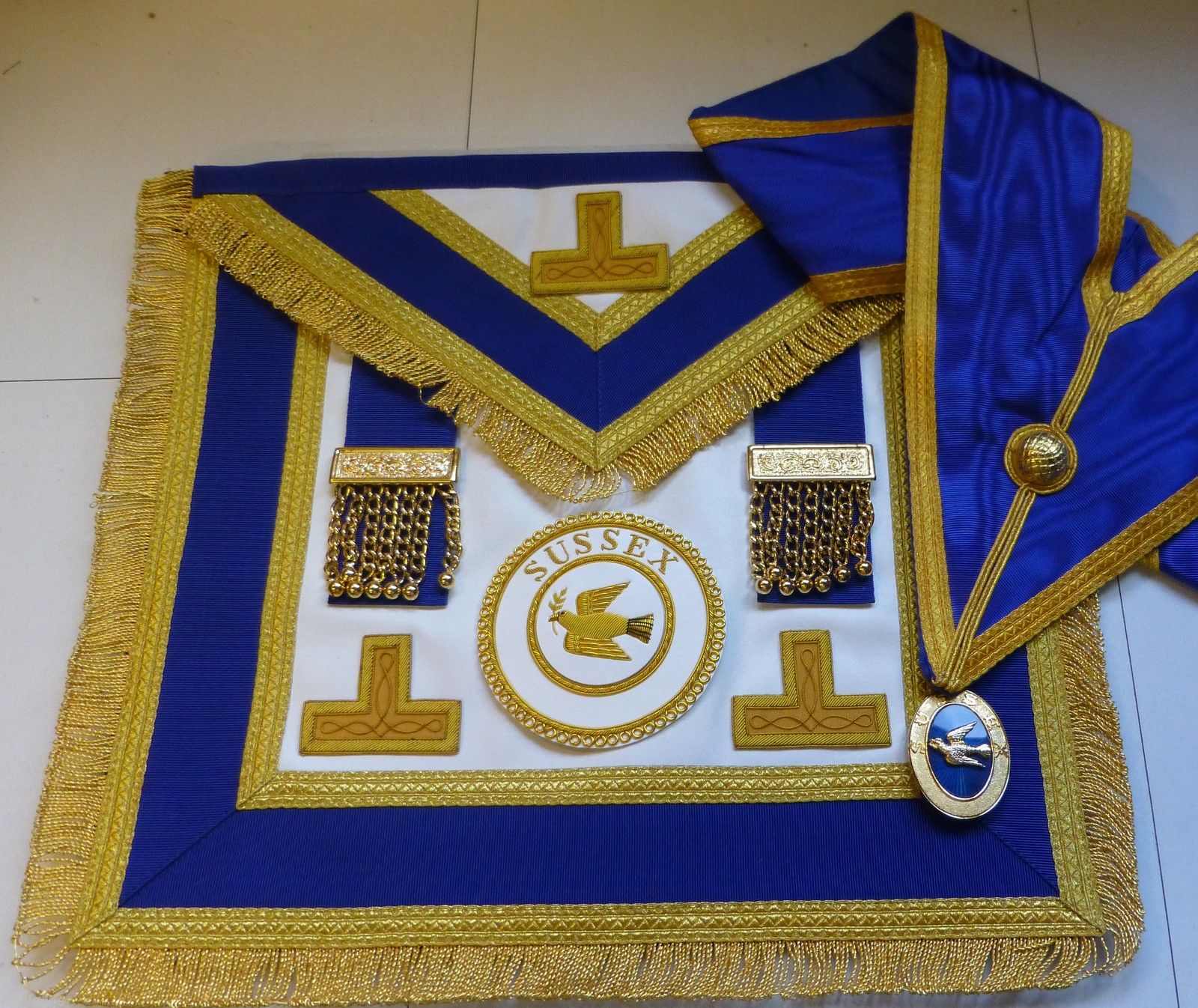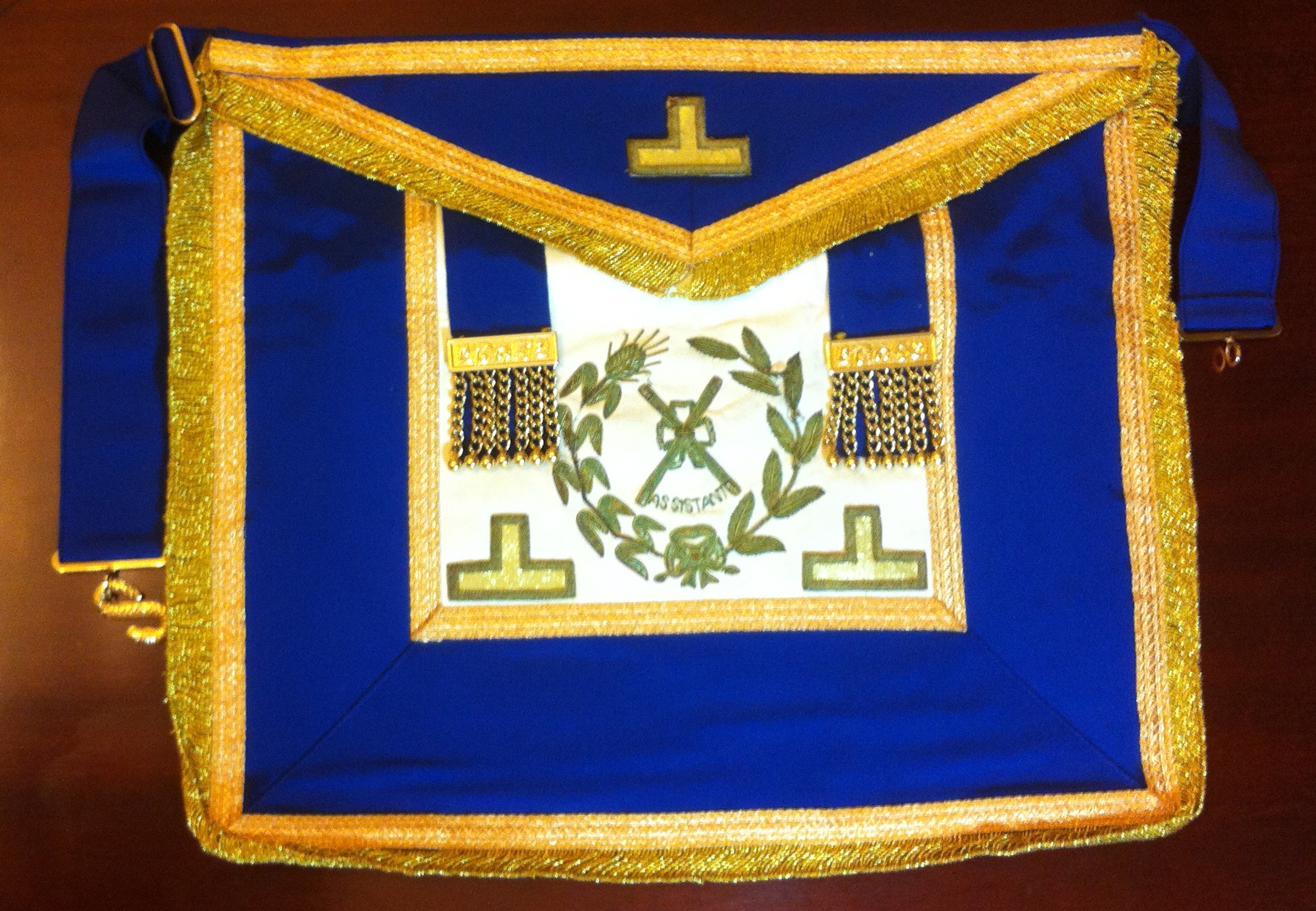The following is a combination of theories as to the design of the Apron used in English Craft Freemasonry, and therefore does not take into account the many variants found in other countries and side orders. It is also important to note that the shapes and symbols are used in many esoteric arenas, and not just confined to Freemasonry, save that their significance are often similar.
In 1814, the Board of Works of the new United Grand Lodge of England, brought in the regulations for the uniformity of Masonic regalia, and particularly in relation to material, design, and decoration of aprons. It is interesting to note that in all three degrees, it is conferred by the Senior Warden and not by the Master. This is because symbolically, the Master represents the spirit of man, and the Senior Warden the soul. It is the soul which registers the spiritual advance of man, and is the link between body and spirit; therefore the outward sign of the spiritual progress made by the Initiate, is conferred by that Officer who represents the soul.
 The Entered Apprentice’s apron is one of white Iamb skin, a sign of innocence and purity. When invested, the wearer has renounced all profane habits and bias, and made himself clean from the exterior influence and ignorant prejudice. He has turned his back upon the darkness, and seeks with a single hearted loyalty, the light that is from the East, and dons the white apron as testimony and reminder. Worn with the flap turned up, the point directed towards the head, indicating that ‘Divine Wisdom’ has not yet completely penetrated the gross matter of our bodies.
The Entered Apprentice’s apron is one of white Iamb skin, a sign of innocence and purity. When invested, the wearer has renounced all profane habits and bias, and made himself clean from the exterior influence and ignorant prejudice. He has turned his back upon the darkness, and seeks with a single hearted loyalty, the light that is from the East, and dons the white apron as testimony and reminder. Worn with the flap turned up, the point directed towards the head, indicating that ‘Divine Wisdom’ has not yet completely penetrated the gross matter of our bodies.
The light blue colour used in the following aprons, has an ancient association with service to the gods; one classic image of this being the Virgin Mary. In Freemasonry it is said to be emblematic of universal beneficence and charity, and teaches us that our hearts and virtue should be as expansive as the blue arch of Heaven.
The Fellowcraft’s apron is worn with flap turned down; this triangle forms the letter V, representing Vescica Piscis, to take a passive form, and thus subordinate to the Master. What of the two rosettes? They serve the dual nature of man, and have a reference to the two pillars. They show that the Fellowcraft is not a complete and united being; body and soul are in union, but not yet in accord with the spirit. There is a striking correspondence with that of the knocks of the Fellowcraft, for they teach the same lesson, as does the positioning of the compasses on the Volume of the Sacred Law .
The design on the Master Mason’s apron includes three rosettes arranged to form a triangle, mirroring that of the flap of the apron. The lower of the two triangles points upwards, representing fire, and the ‘Divine Spark’ or Spirit. The other, formed by the flap, pointing downwards, is the triangle of water, and is thus representative of the soul. Both of these triangles are within a square – the emblem of matter, and therefore of the body. Thus we see that the Master Mason’s apron represents the three fold nature of man.
The operative Mason fixed his apron by way of string, as still used on the Entered Apprentice’s. Early speculative Masons decorated these with tassels; today the tassels have been detached, merely becoming strips of ribbon, to each of which is attached seven chains. The number seven is again meaningful; it consists of three representing spirit, and four representing matter; therefore God and Man, and likewise all creation, which is compounded of spirit and matter. It is also argued that it represents on the right hand side, the seven Liberal Arts and Sciences : Grammar, Rhetoric, Logic, Arithmetic, Geometry, Music and Astronomy. While on the left, nearest the heart; Faith, Hope, Charity, Prudence, Temperance, Fortitude and Justice. Another interpretation is that it represents the increasing levels of wisdom through the seven ages of man, influenced by the planets. And finally, seven is the number required to form a perfect Lodge.
The modern method of fastening the apron, by means of a hook and eye, is interesting. The snake (Ouroboros) is one of the oldest and most venerated of symbols. The serpent fastening the apron is biting its tail, indicating that we are encircled by the eternal Holy Wisdom and mystical insight.
The Master of the Lodge has an apron which bears three “T” shaped ornaments, which replace the rosettes found on that of the Fellowcraft. Theories behind this include the principle that when conjoined they form the Triple Tau, linking it to Royal Arch. The shape itself has early Christian overtones, referring to the crucifixion. It has also been recorded as representing the old T-Square used by skilled operatives; and the shape of a ‘Cornerstone’ in the 15th Century, requiring the skill of a Master Mason.
Other aprons found in Craft, depict seniority; Provincial officers wear an apron of Garter blue, with the emblem of their rank in the centre of the apron. 
Grand Officers again have an apron of Garter blue, but is of a broader band, conveying a closer association with royalty and rulership. In the centre of the apron, is a wreath composed of a sprig of acacia and an ear of corn, and these have mention within our ritual.  But there is wider meaning; acacia is a symbol of humanity, as a tree it symbolises the centre of the world, and spiritual growth linking Earth to the Heavens; the Ear of Corn is emblematic of the abundance of life and resurrection.
But there is wider meaning; acacia is a symbol of humanity, as a tree it symbolises the centre of the world, and spiritual growth linking Earth to the Heavens; the Ear of Corn is emblematic of the abundance of life and resurrection.
The Assistant Grand Master’s apron is as other Grand Officers, but has in addition, the square and compasses in the centre (representing Heaven and Earth/Morality and Virtue), with gold embroidered pomegranates and lotus alternating on the edging. The colour Gold represents perfection in mind and body; pomegranates mean eternity; while the lotus is symbolic of a journey through life which is a progression of enlightenment; its unfolding petals in daylight likened to the expansion of the soul, together with purity of mind and action.
The Deputy Grand Master’s has the same, but for the addition of a five pointed star, or Pentalpha, an emblem of perfection and protection. The Grand Master’s is the same as other Grand Officers, but with the Sun (sometimes referred to as the blazing star of enlightenment), in the centre, a symbol of light and glory, the mystic centre of the universe and provider of life. It also has seven eared wheat at each corner; wheat has for many centuries been a symbol of harvest, and the sharing of bread and therefore wisdom.
One unique apron in Craft Masonry is that of Grand Stewards, the history of which is a subject for further reading. Suffice to say, their aprons are of crimson, denoting fire and blood, which stood for sacrifice.
In conclusion, we can see that design is not by accident, and although the true meaning may have been lost in the mists of time, the various theories all have a similar theme. The apron is probably the most important symbol in Freemasonry, as it represents the philosophical principles as to why the speculative form exists.
By Bro. P. Doran
Article reproduced by the kind permission of The Temple of Athene Lodge 9541, Prov.of Middlesex.Trans.vol.15-Sept 2009.
- His Majesty’s Servant , David Garrick Esq – Freemason ? - June 7, 2024
- Influencia de la Masonería en Chile - April 29, 2024
- Pomegranate in Freemasonry – its significance - March 11, 2024

